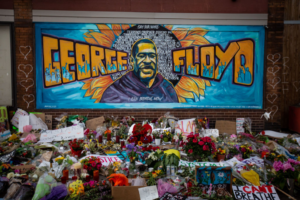Systemic Injustice: How George Floyd’s Death Highlights a Widespread Issue Among American Police Departments

The brutal murder of George Floyd by Minneapolis police, which was captured on video, has sparked social outrage in cities across the United States. After video surfaced of former Minneapolis police officer Derek Chauvin kneeling on Floyd’s neck for nearly nine minutes, protestors took to the streets to express their frustration with the continued mistreatment of African Americans by police. Today, we offer readers a brief synopsis of the events leading up to George Floyd’s tragic death, and use this horrific situation to highlight a systemic issue plaguing police departments – officers with disciplinary issues being allowed to continue policing America’s communities.
What You Need to Know About the Death of George Floyd
On the evening of May 25, 2020, an employee at Cup Foods in Minneapolis, Minnesota called 911 to report that George Floyd allegedly provided the store with a counterfeit $20 bill in exchange for cigarettes. According to the 911 call transcript, Floyd would not give the cigarettes back and appeared “drunk” and “not in control of himself.” However, the owner of Cup Foods described Floyd as a “pleasant” regular of the store and assumed that Floyd may not have even known the bill was counterfeit.
Police arrived on the scene and, though it is not clear why, Officer Thomas Lane approached Floyd’s vehicle and quickly drew his weapon, pointing it at Floyd in the driver’s seat. More evidence regarding this exchange will likely be revealed once the body camera footage is released, but Floyd then exited the vehicle, was handcuffed by police, and proceeded to be moved toward the police car. While being moved to the car, Floyd stiffened up and began telling police that he was claustrophobic. At this point, Officers Derek Chauvin and Tou Thoa also arrived on scene.
In a heartbreaking moment that has since been broadcasted across screens around the world, Chauvin then knelt on Floyd’s neck for a total of 8 minutes and 46 seconds. Onlookers pleaded with officers to get off of Floyd, and Floyd himself continuously told police “I can’t breathe,” and repeated the phrases “Mama” and “please.” After police finally checked for a pulse and failed to find one, Floyd was transferred to Hennepin County Medical Center where he was pronounced dead. This disturbing encounter can be seen HERE.
Floyd’s death led to extensive protesting across the country, as large groups displayed their frustration with the criminal justice system’s history of violence against the African American community. Some of these protests even turned violent, with urban areas like Chicago, Minneapolis, New York, and Washington D.C. experiencing severe looting and property damage.
All four officers involved in the killing were promptly fired from the Minneapolis Police Department. Then, four day after Floyd’s death, the Hennepin County State’s Attorney’s office announced that it had charged Derek Chauvin with Third-Degree Murder and Manslaughter (the criminal complaint can be found HERE). Hennepin County delayed in seeking charges against the other three officers, leading to continued protests through dozens of cities around the world. However, on June 3, Minnesota’s Attorney General Keith Ellison announced that he would elevate Chauvin’s charge to Second-Degree Murder and also charge the other three involved officers with aiding and abetting murder.
Police Violence Towards Minorities is More Than “One Bad Apple”
In cases of deadly force used by police officers, departments often defend themselves on the basis of an officer being “a bad apple,” i.e., one officer went “rouge” but their actions do not represent a more widespread problem. However, a closer examination of several recent deaths caused by police (particularly those that involved minority victims) reveals a more systemic issue. That is, many officers involved in these fatal tragedies also have a history of violent, aggressive, or unstable behavior that would be harmful in any workplace, especially one tasked with serving and protecting American communities.
The murder of George Floyd is a prime example of this pattern. Here, Minneapolis Police Department records show that former officer Derek Chauvin received 17 misconduct complaints since he was hired in 2001. While the official police records do not detail the complaints against Chauvin, the Washington Post recently reported that Chauvin was involved in at least three additional uses of deadly force by Minneapolis police that either turned into criminal charges or internal investigations. Furthermore, Officer Tou Thoa was also the defendant in an excessive force lawsuit after allegedly beating a suspect who had been detained for a random search. Thoa settled the lawsuit outside of court in 2017.
The city of Minneapolis itself is also facing strong criticism for its history of violence against minorities. Specifically, the New York Times reported that, while African Americans make up around 20% of the Minneapolis population, data shows that African Americans are more likely than whites to be pulled over or arrested in Minneapolis. Moreover, from 2009-2019, 60% of the victims of the Minneapolis police shooting were black. In fact, a 2015 Department of Justice report recommended that Minneapolis undergo significant reform with respect to police accountability and the City’s handling of police misconduct cases.
Though Derek Chauvin is the most recent example of an officer with a history of misconduct issues killing an African American, he is by no means the only one. For instance, the shooting of Breonna Taylor in Louisville, Kentucky was committed by three police officers that all had previous misconduct issues. Specifically, one officer was sued for excessive force after firing his gun into a vehicle 11 times, and another was the subject of a professionalism standards investigation related to a drug arrest. A full description of these officers’ employment histories can be found HERE.
Another example of this systemic issue concerns the shooting of Eric Logan in South Bend, Indiana. Coffman Law’s work on this matter was summarized HERE, but briefly, Eric Logan was shot and killed by former South Bend Police Officer Ryan O’Neill in June 2019. O’Neill states that he shot his firearm because Logan allegedly attacked him with a knife. In 2008, O’Neill’s colleagues claimed that he used derogatory language to describe Muslims and bi-racial couples. Additionally, after the State of Indiana completed its criminal investigation in this shooting, it also discovered that O’Neill had picked up and paid a prostitute for a sex act in May 2019.
In addition to the cases described above, a similar pattern of unstable officer conduct prior to the incident has been seen in the deaths of Freddie Gray, Tamir Rice, Eric Harris, and more. Clearly this pattern has evolved into a systemic issue plaguing police departments across the country, and action must be taken to combat such a widespread problem. Whether that change starts with enhanced sensitivity training, increased police accountability, or more stringent policies with respect to misconduct complaints and investigations against officers, one thing is clear – our minority communities deserve better treatment from police.
About Coffman Law Offices, P.C.
Coffman Law is committed to providing superb legal representation for people who are suffering from severe personal injuries or are dealing with the loss of a loved one due to negligence or misconduct. Coffman Law is a small, results-driven firm focused on ensuring that clients receive the compassion, attention, and consideration that they need to seek adequate redress for injuries or loss. The firm is led by Owner and Founding Partner Brian Coffman, who has dedicated his career to helping accident victims navigate the legal system and obtain redress for their injuries. If you have been injured or lost a loved one, contact Coffman Law today for a free consultation.




